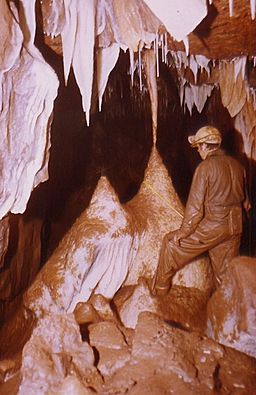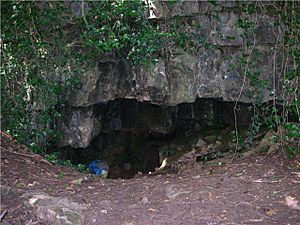Otter Hole facts for kids
Quick facts for kids Otter Hole |
|
|---|---|

Inside Otter Hole
|
|
| Location | St Arvans, Monmouthshire, Wales |
| Depth | 60m |
| Length | 3.352km |
| Geology | Limestone |
| Entrances | 1, accessed through tidal sump. |
| Access | Gated, with permission and guidance of a warden |
Otter Hole is one of Britain's most beautifully decorated caves. It is located near the England–Wales border just north of Chepstow. This amazing cave runs from the banks of the River Wye right under the Chepstow Racecourse.
Inside, you'll find many different chambers. Each chamber is filled with incredible cave formations. Because Otter Hole is so special, access is limited. The Royal Forest of Dean Caving Club manages who can visit. They do this to protect the cave's delicate features.
Contents
Exploring Otter Hole: A Journey Underground
The entrance to Otter Hole is on the banks of the River Wye. It's a gated doorway at the bottom of a small cliff. This gate is always locked. It helps protect the rare formations inside. It also stops people from accidentally getting trapped when the tide comes in.
Getting Past the Sump
After entering, you'll crawl through a short passage. There are a few tight squeezes. Then, the passage opens up to a "beach" area. Here, a tidal sump blocks the way. A sump is a part of a cave passage that is completely filled with water.
At low tide, this sump quickly drains. It makes a loud noise as the water goes out. Once drained, you can pass through it. You have to "duck" under a double opening that looks like a figure 8.
Timing Your Trip
The tide affects when you can enter the cave. This means two types of trips are possible. A "between tide trip" lasts about 6 hours. You enter just after the sump drains. You leave just before it fills up again.
An "overtide trip" means you pass the sump just before it closes. This gives you much more time inside. You can explore for 9 to 15 hours.
The Streamway and Chambers
After the sump, you follow a fairly straight path. This path goes along an active streamway. Eventually, you reach a pool. Many cavers use this pool to wash off thick estuarine mud. This helps keep the delicate formations clean.
Beyond this, you'll find a few boulder chokes. These are areas where the passage is blocked by many large rocks. Once past these, you'll discover many well-decorated chambers.
The Hall of 30
The largest chamber is called the Hall of 30. It is filled with many huge stalagmites. Stalagmites are formations that grow up from the cave floor. They come in many colors. You can see pure white, oranges, yellows, and even pure black.
The different colors come from various minerals. These minerals seep through the rock above. Then they are deposited as the formations grow. White forms are made of natural calcium carbonate. Elements like arsenic can create the black forms.
Deep Inside the Cave
The amazing formations continue beyond the Hall of 30. The passage changes character again. This happens at the junction of Tunnels Left and Right. The very back of the cave is often called "Camp." It is also full of wonderful formations.
You might see straws. These are thin, hollow tubes of mineral. There are also helictites, which are twisted, gravity-defying formations. And you can find "pom poms," which look like fluffy balls. The journey back takes you through the Hall of 30. Then you follow the streamway back towards the sump.
Protecting Otter Hole: Conservation Efforts
Otter Hole has a unique collection of formations. Because of this, access is limited. You need to book trips well in advance. You do this through the Otter Hole Secretary.
Helping with Conservation
People who go on trips might be asked to help with conservation work. This can include cleaning the stalagmites and drapes. It might also involve laying tape to guide visitors. Sometimes, it's just cleaning up any rubbish found.
All trips are led by wardens from the Royal Forest of Dean Caving Club. They guide visitors and help control any impact on the cave. This ensures the cave remains beautiful for future explorers.
Otter Hole is a Site of Special Scientific Interest (SSSI). This means it's a specially protected area. It's recognized for its important natural features.


